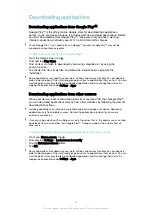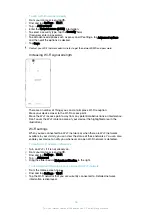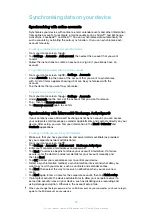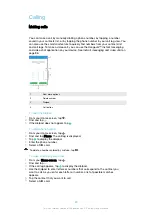
Screen pinning
Use screen pinning to set your device to display only the screen for a specific
application. For example, if you are playing a game and you accidentally touch the
Home navigation key, the screen pinning feature prevents the active game app screen
from being minimised. You can also use this feature when you lend your device to
another person to make it harder for them to access more than one screen or
application. For example, you can lend your phone to somebody to make a phone
call and pin the screen to the Phone application so that the person can't easily use
other apps such as Messaging or Email.
Screen pinning is not a security feature and does not fully prevent other users from unpinning a
screen and accessing your device. To protect your data, you should set up your device to
request a screen lock PIN, password or pattern before someone can unpin the screen.
To activate screen pinning
1
From your Home screen, tap .
2
Find and tap
Settings
>
Security
>
Screen pinning
.
3
Drag the slider to the right.
4
If you have not set up a pattern, PIN or password screen lock on your device,
drag the slider beside
Lock device when unpinning
to the right and then select
an option. If you already have a screen lock enabled, then drag the slider to
activate the relevant security option after you activate screen pinning.
A pattern, PIN or password is not mandatory for screen pinning to work.
To pin a screen
1
Make sure that screen pinning is activated on your device.
2
Open an app and go to the screen that you want to pin.
3
Tap .
4
To display the screen pinning icon , swipe upwards.
5
Tap .
6
In the popup window that appears, tap
Got it
.
To unpin a screen
1
On the pinned screen, touch and hold and at the same time.
2
Release both buttons.
If you selected a security option when you activated the screen pinning function, you have to
enter your pattern, PIN or password to unlock the device before the screen can be unpinned.
Application settings
Some apps will ask for permissions once you start using them. You can allow or deny
permissions individually for each app, either from the Settings menu or from the
Permission confirm dialog. Permission requirements depend on the app’s design.
Allowing or denying permissions
You can choose whether to allow or deny permissions when the dialog is shown. If
you have used another Android version previously, most apps will have already been
granted the necessary permissions.
To allow a permission
1
To allow a permission, tap
Allow
.
2
When the confirm dialog appears for the second time, you can choose the
Never ask again
option if you wish.
3
A dialog will also explain why the app needs the permissions and what it uses
them for specifically. To dismiss this dialog, tap
OK
.
57
This is an internet version of this publication. © Print only for private use.
Содержание E5343
Страница 1: ...User guide Xperia C4 dual E5333 E5363 ...






























